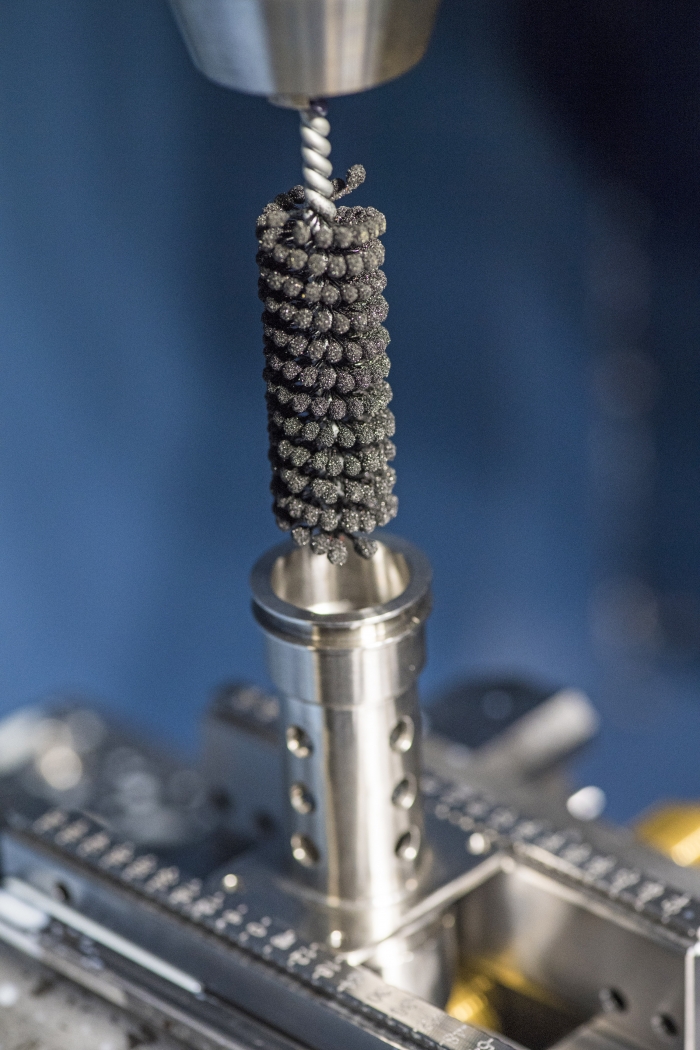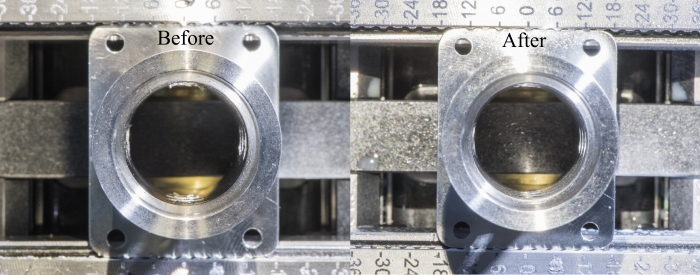Article from Brush Research Manufacturing Co. Inc.
By its very nature, high-nickel, iron or cobalt alloy steels, including Monel, Inconel, Incoloy, Invar, Rene and Hasteloy, are some of the most difficult materials to machine. Because these superalloys are designed to deliver high strength at extremely high temperatures in components often found in “hot” sections of engines and turbines, the stresses and heat generated during machining are considerable.
In this process, the edge of the cutting tool is exposed to considerable mechanical stress, strain and heat. High compressive and shearing forces attack this edge, increasing temperatures such that the cutting tools can begin to lose hardness. This can produce a “gummy” machining behavior and also cause workhardening.

According to Janos Garaczi, president of Delta Machine Co. LLC., a company that specializes in machining complex, tight-tolerance parts out of titanium, nickel alloys, stainless steel, aluminum, plastics and other exotic alloys, this is caused when chips do not break away cleanly from the workpiece. Instead, the material is just "pushed" to one side.
“It can be really difficult to turn or mill this type of material because it doesn’t produce a clear shearing action. Instead it just kind of pushes the material to the side,” explains Garaczi.
“Gummy” machining is also the cause of heavy burrs in drilled holes or grooves.
“The burrs are one of the biggest problems,” adds Garaczi. “Even during ‘grooving,’ if you cut the material from one side, it just pushes the burr to the edge; and if you approach it from the other side, it just pushes it back. It doesn’t want to break off the material cleanly. As soon as the tool gets a bit dull it gets a lot worse so sharp tools with the right geometry are key.”
The general poor machinability ultimately compromises surface integrity of the parts, says Garaczi, which is problematic given that is one of the primary causes of failure of these types of components.
Given the critical nature of the applications in which these components are utilized, most machined superalloy parts must therefore undergo a surface finishing operation to remove workhardened layers and any heavy burrs. Doing so has additional benefits, including reducing the risk of oxidation and stress corrosion cracking (SCC).
Although this has traditionally been achieved through an expensive, messy and time-consuming grinding process, new flexible hones are simplifying the task by incorporating one of the toughest, hardest materials on the planet: CBN.
CBN combines the highest hardness with excellent toughness to provide the optimum surface finish. Flexible hones made of this type of material can be mounted on CNC equipment for automated operations or used in the field with handheld power tools to wear away work-hardened surfaces without inducing additional thermal distortion.

Superalloys
High-nickel alloy steels are prized within these markets because of the excellent resistance to corrosion and heat with strength, toughness, metallurgical stability, and weldability. These superalloys are a great choice for applications that require chemical resistance and strength at elevated characteristics. Their material properties include low expansion at severe temperatures and creep resistance under high stress conditions.
As such, superalloys are widely used as material for the hottest parts of complex equipment, including nuclear power components, high-performance automotive parts and jet engine turbines. Nickel, iron and cobalt alloys are also used broadly for aerospace components, medical devices, petrochemical and refining applications and thermal processing.
According to Garaczi, with the right cutting tools milling nickel alloys and stainless steels is still limited as to the surface finish that can be achieved to at best 32 Ra. With turning, 16 Ra is possible, but most of the time it requires a grinding or polishing step.
“Grinding is a very common process in these cases, but it is very time consuming and very expensive to have to grind a part," he says. "In some cases, it could take longer than the initial machining.”
As a result, Garaczi says Delta Machine often sends parts out for grinding or polishing, opting to not perform this type of operation in house.
Flexible Hones
For many machine shops, a flexible hone is a much more efficient tool for overall surface finishing. The low-cost tool is often used for sophisticated surfacing, deburring, edge-blending and cleaning.
Until recently, however, flexible hones with CBN abrasive were only available by special order. Now, the company that invented the Flex-Hone tool, Brush Research Manufacturing, Los Angeles, offers CBN surface finishing solutions part of its standard product line.
Somewhat resembling a spinning bottlebrush, the Flex-Hone tool is characterized by abrasive globules that are permanently mounted to flexible filaments that are attached to a center shaft. With its low-pressure, low-temperature abrading process, BRM’s CBN Flex-Hone tools can remove workhardened layers and deburr parts without disturbing the underlying metallurgical structure.
Standard CBN Flex-Hone tools come in sizes ranging from 4mm to 20mm in three different mesh sizes: 170/200, 800, and 2500. Larger sized products from 22mm to 38mm and additional mesh sizes are available by special order.
Garaczi says he can see the advantage of being able to install a flexible hone into CNC equipment to automate the process and speed up the time when finishing superalloys and stainless steels.
Garaczi is in a unique position, having started with the company as a machinist and eventually working his way to president and owner. As such, he remains responsible for much of the programming, setups and purchasing.
He says when making decisions about what tools to purchase it is often on a project-by-project basis. However, if the tool can reduce cycle times versus its cost, it is an easy decision.
“There are definitely scenarios where it would be good to be able to perform surface finishing of this type of material on CNCs,” says Garaczi. “It would really save a lot of time and extra processing cost.”
Related Glossary Terms
- abrasive
abrasive
Substance used for grinding, honing, lapping, superfinishing and polishing. Examples include garnet, emery, corundum, silicon carbide, cubic boron nitride and diamond in various grit sizes.
- alloy steels
alloy steels
Steel containing specified quantities of alloying elements (other than carbon and the commonly accepted amounts of manganese, sulfur and phosphorus) added to cause changes in the metal’s mechanical and/or physical properties. Principal alloying elements are nickel, chromium, molybdenum and silicon. Some grades of alloy steels contain one or more of these elements: vanadium, boron, lead and copper.
- alloys
alloys
Substances having metallic properties and being composed of two or more chemical elements of which at least one is a metal.
- burr
burr
Stringy portions of material formed on workpiece edges during machining. Often sharp. Can be removed with hand files, abrasive wheels or belts, wire wheels, abrasive-fiber brushes, waterjet equipment or other methods.
- computer numerical control ( CNC)
computer numerical control ( CNC)
Microprocessor-based controller dedicated to a machine tool that permits the creation or modification of parts. Programmed numerical control activates the machine’s servos and spindle drives and controls the various machining operations. See DNC, direct numerical control; NC, numerical control.
- cubic boron nitride ( CBN)
cubic boron nitride ( CBN)
Crystal manufactured from boron nitride under high pressure and temperature. Used to cut hard-to-machine ferrous and nickel-base materials up to 70 HRC. Second hardest material after diamond. See superabrasive tools.
- gang cutting ( milling)
gang cutting ( milling)
Machining with several cutters mounted on a single arbor, generally for simultaneous cutting.
- grinding
grinding
Machining operation in which material is removed from the workpiece by a powered abrasive wheel, stone, belt, paste, sheet, compound, slurry, etc. Takes various forms: surface grinding (creates flat and/or squared surfaces); cylindrical grinding (for external cylindrical and tapered shapes, fillets, undercuts, etc.); centerless grinding; chamfering; thread and form grinding; tool and cutter grinding; offhand grinding; lapping and polishing (grinding with extremely fine grits to create ultrasmooth surfaces); honing; and disc grinding.
- hardness
hardness
Hardness is a measure of the resistance of a material to surface indentation or abrasion. There is no absolute scale for hardness. In order to express hardness quantitatively, each type of test has its own scale, which defines hardness. Indentation hardness obtained through static methods is measured by Brinell, Rockwell, Vickers and Knoop tests. Hardness without indentation is measured by a dynamic method, known as the Scleroscope test.
- machinability
machinability
The relative ease of machining metals and alloys.
- milling
milling
Machining operation in which metal or other material is removed by applying power to a rotating cutter. In vertical milling, the cutting tool is mounted vertically on the spindle. In horizontal milling, the cutting tool is mounted horizontally, either directly on the spindle or on an arbor. Horizontal milling is further broken down into conventional milling, where the cutter rotates opposite the direction of feed, or “up” into the workpiece; and climb milling, where the cutter rotates in the direction of feed, or “down” into the workpiece. Milling operations include plane or surface milling, endmilling, facemilling, angle milling, form milling and profiling.
- milling machine ( mill)
milling machine ( mill)
Runs endmills and arbor-mounted milling cutters. Features include a head with a spindle that drives the cutters; a column, knee and table that provide motion in the three Cartesian axes; and a base that supports the components and houses the cutting-fluid pump and reservoir. The work is mounted on the table and fed into the rotating cutter or endmill to accomplish the milling steps; vertical milling machines also feed endmills into the work by means of a spindle-mounted quill. Models range from small manual machines to big bed-type and duplex mills. All take one of three basic forms: vertical, horizontal or convertible horizontal/vertical. Vertical machines may be knee-type (the table is mounted on a knee that can be elevated) or bed-type (the table is securely supported and only moves horizontally). In general, horizontal machines are bigger and more powerful, while vertical machines are lighter but more versatile and easier to set up and operate.
- polishing
polishing
Abrasive process that improves surface finish and blends contours. Abrasive particles attached to a flexible backing abrade the workpiece.
- stainless steels
stainless steels
Stainless steels possess high strength, heat resistance, excellent workability and erosion resistance. Four general classes have been developed to cover a range of mechanical and physical properties for particular applications. The four classes are: the austenitic types of the chromium-nickel-manganese 200 series and the chromium-nickel 300 series; the martensitic types of the chromium, hardenable 400 series; the chromium, nonhardenable 400-series ferritic types; and the precipitation-hardening type of chromium-nickel alloys with additional elements that are hardenable by solution treating and aging.
- superalloys
superalloys
Tough, difficult-to-machine alloys; includes Hastelloy, Inconel and Monel. Many are nickel-base metals.
- turning
turning
Workpiece is held in a chuck, mounted on a face plate or secured between centers and rotated while a cutting tool, normally a single-point tool, is fed into it along its periphery or across its end or face. Takes the form of straight turning (cutting along the periphery of the workpiece); taper turning (creating a taper); step turning (turning different-size diameters on the same work); chamfering (beveling an edge or shoulder); facing (cutting on an end); turning threads (usually external but can be internal); roughing (high-volume metal removal); and finishing (final light cuts). Performed on lathes, turning centers, chucking machines, automatic screw machines and similar machines.
- workhardening
workhardening
Tendency of all metals to become harder when they are machined or subjected to other stresses and strains. This trait is particularly pronounced in soft, low-carbon steel or alloys containing nickel and manganese—nonmagnetic stainless steel, high-manganese steel and the superalloys Inconel and Monel.
